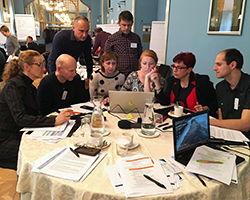WHO launches cutting-edge package to scale up risk communication capacity in the European Region in 5 steps

WHO
Emergency risk communication (ERC) is a vital public health intervention. It can save lives during emergency situations and, as such, should be considered an investment in people’s health, safety and security.
Starting today, a new package is available to guide countries of the Region in establishing systems and plans for effective ERC tailored to their specific contexts. The package is the result of a pioneering project launched by WHO/Europe in March 2017.
The pilot phase
The following 5 steps can make a difference in how effectively risks are communicated during health emergencies:
- training to build homogeneous capacity based on a country’s priority hazards;
- capacity-mapping to identify needs and gaps in view of strengthening in-country ERC;
- plan-writing to develop a multihazard ERC plan based on a WHO template;
- plan-testing through multisectoral simulation and tabletop exercises; and
- plan adoption to update the national ERC plan and integrate it into national preparedness and response plans.
The first phase of the ERC project, financed by the Federal Ministry of Health of Germany, focused on working closely with 13 countries of the Region to pilot the 5-step capacity-building package at different stages. A newly released report details this phase, which targeted Armenia, Bosnia and Herzegovina, Estonia, Kyrgyzstan, Romania, Serbia, Slovakia, Slovenia, Sweden, Tajikistan, Turkey, Turkmenistan and Ukraine.
“This initiative demonstrates that a great deal can be accomplished with political will, adequate financing and new methods,” says Dr Nedret Emiroglu, Director of the Division of Health Emergencies and Communicable Diseases at WHO/Europe. “I am confident that the process and results described in the report will inspire other regions, countries and territories to achieve fast, effective, predictable communications responses to all types of health emergencies.”
From training to national plan adoption
ERC strongly affects responses to and outcomes of public health emergencies. It is a vital thread that runs through the prevention, preparedness, response and recovery phases, and yet there have been few large-scale efforts to build national capacity in this area until now.
For the first time, the 5-step package brings together all of these elements. It enabled WHO/Europe to collaborate with each enrolled country and territory to move towards the adoption and integration of their ERC plan into national systems. Over the course of a year, WHO/Europe supported the following activities in participating countries and territories:
- 10 ERC capacity-mapping workshops;
- 10 multisectoral ERC trainings;
- 7 ERC plan-writing sessions; and
- 3 ERC plan-testing exercises.
On 1 March 2018, Turkmenistan became the first country of those enrolled in the project to adopt a national ERC plan.
Feedback on the process has been positive. As a workshop participant from Bosnia and Herzegovina notes, “When we know each other better, we can improve communication. Thanks to the relationships we’ve gained through this workshop, we can do better.”
“The in-country missions have been a unique learning opportunity for us,” says Ms Cristiana Salvi, External Relations Manager for the Division of Health Emergencies and Communicable Diseases at WHO/Europe and coordinator of the project. “They have allowed us to systematically feed a wealth of information, evidence and stories from people on the ground back into the tools, thus making them relevant to their own needs. The tools we are launching today are unique as they reflect real-life experience.”
Looking ahead to the second phase
The second implementation phase of the 5-step package has been underway since March 2018, providing continued support to pilot countries and territories while expanding to other priority countries in the Region.
With sustained financial support, WHO/Europe’s ERC project will continue to meet countries’ and territories’ requests to increase their ability to communicate before, during and after emergencies, and ultimately help make Europe and the world safer from public health emergencies.



